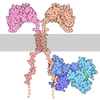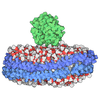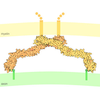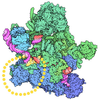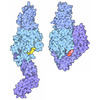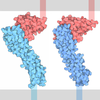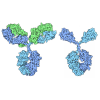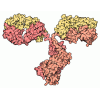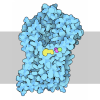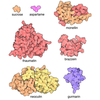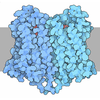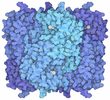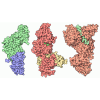+ Open data
Open data
- Basic information
Basic information
| Entry | Database: PDB / ID: 9c3e | |||||||||||||||||||||
|---|---|---|---|---|---|---|---|---|---|---|---|---|---|---|---|---|---|---|---|---|---|---|
| Title | TCR - CD3 complex bound to HLA | |||||||||||||||||||||
 Components Components |
| |||||||||||||||||||||
 Keywords Keywords | IMMUNE SYSTEM / T-cell receptor / TCR / 1G4 / nanodisc / CD3 / HLA / NY-ESO-1 | |||||||||||||||||||||
| Function / homology |  Function and homology information Function and homology informationtRNA threonylcarbamoyladenosine metabolic process / regulation of lymphocyte apoptotic process / gamma-delta T cell receptor complex / Fc-gamma receptor III complex / T cell anergy / positive regulation of cell-cell adhesion mediated by integrin / positive regulation of T cell anergy / gamma-delta T cell activation / Fc-gamma receptor signaling pathway / CD4-positive, alpha-beta T cell proliferation ...tRNA threonylcarbamoyladenosine metabolic process / regulation of lymphocyte apoptotic process / gamma-delta T cell receptor complex / Fc-gamma receptor III complex / T cell anergy / positive regulation of cell-cell adhesion mediated by integrin / positive regulation of T cell anergy / gamma-delta T cell activation / Fc-gamma receptor signaling pathway / CD4-positive, alpha-beta T cell proliferation / negative thymic T cell selection / positive regulation of CD4-positive, alpha-beta T cell proliferation / alpha-beta T cell receptor complex / positive regulation of protein localization to cell surface / positive thymic T cell selection / signal complex assembly / Nef and signal transduction / positive regulation of cell-matrix adhesion / T cell receptor complex / smoothened signaling pathway / establishment or maintenance of cell polarity / Translocation of ZAP-70 to Immunological synapse / Phosphorylation of CD3 and TCR zeta chains / positive regulation of interleukin-4 production / dendrite development / protein complex oligomerization / alpha-beta T cell activation / Generation of second messenger molecules / FCGR activation / immunological synapse / Co-inhibition by PD-1 / Role of phospholipids in phagocytosis / T cell receptor binding / positive regulation of T cell proliferation / T cell costimulation / positive regulation of interleukin-2 production / cerebellum development / FCGR3A-mediated IL10 synthesis / positive regulation of calcium-mediated signaling / : / : / T cell activation / cell surface receptor protein tyrosine kinase signaling pathway / protein tyrosine kinase binding / positive regulation of receptor binding / early endosome lumen / Nef mediated downregulation of MHC class I complex cell surface expression / negative regulation of receptor binding / DAP12 interactions / cellular response to iron ion / negative regulation of smoothened signaling pathway / Endosomal/Vacuolar pathway / Antigen Presentation: Folding, assembly and peptide loading of class I MHC / FCGR3A-mediated phagocytosis / peptide antigen assembly with MHC class II protein complex / apoptotic signaling pathway / cellular response to iron(III) ion / antigen processing and presentation of exogenous protein antigen via MHC class Ib, TAP-dependent / MHC class II protein complex / negative regulation of forebrain neuron differentiation / clathrin-coated endocytic vesicle membrane / calcium-mediated signaling / ER to Golgi transport vesicle membrane / peptide antigen assembly with MHC class I protein complex / regulation of erythrocyte differentiation / regulation of iron ion transport / MHC class I peptide loading complex / response to molecule of bacterial origin / HFE-transferrin receptor complex / T cell mediated cytotoxicity / antigen processing and presentation of endogenous peptide antigen via MHC class I / positive regulation of T cell cytokine production / antigen processing and presentation of exogenous peptide antigen via MHC class II / MHC class I protein complex / positive regulation of immune response / peptide antigen binding / Regulation of actin dynamics for phagocytic cup formation / SH3 domain binding / negative regulation of neurogenesis / positive regulation of T cell mediated cytotoxicity / positive regulation of receptor-mediated endocytosis / multicellular organismal-level iron ion homeostasis / positive regulation of T cell activation / cellular response to nicotine / positive regulation of type II interferon production / specific granule lumen / phagocytic vesicle membrane / recycling endosome membrane / positive regulation of cellular senescence / Immunoregulatory interactions between a Lymphoid and a non-Lymphoid cell / negative regulation of epithelial cell proliferation / Interferon gamma signaling / MHC class II protein complex binding / positive regulation of protein binding / Modulation by Mtb of host immune system / late endosome membrane / sensory perception of smell / transmembrane signaling receptor activity / tertiary granule lumen / DAP12 signaling Similarity search - Function | |||||||||||||||||||||
| Biological species |  Homo sapiens (human) Homo sapiens (human) | |||||||||||||||||||||
| Method | ELECTRON MICROSCOPY / single particle reconstruction / cryo EM / Resolution: 3.5 Å | |||||||||||||||||||||
 Authors Authors | Notti, R.Q. / Walz, T. | |||||||||||||||||||||
| Funding support |  United States, 6items United States, 6items
| |||||||||||||||||||||
 Citation Citation |  Journal: bioRxiv / Year: 2024 Journal: bioRxiv / Year: 2024Title: The resting and ligand-bound states of the membrane-embedded human T-cell receptor-CD3 complex. Authors: Ryan Q Notti / Fei Yi / Søren Heissel / Martin W Bush / Zaki Molvi / Pujita Das / Henrik Molina / Christopher A Klebanoff / Thomas Walz Abstract: The T-cell receptor (TCR) initiates T-lymphocyte activation, but mechanistic questions remain( ). Here, we present cryogenic electron microscopy structures for the unliganded and human leukocyte ...The T-cell receptor (TCR) initiates T-lymphocyte activation, but mechanistic questions remain( ). Here, we present cryogenic electron microscopy structures for the unliganded and human leukocyte antigen (HLA)-bound human TCR-CD3 complex in nanodiscs that provide a native-like lipid environment. Distinct from the "open and extended" conformation seen in detergent( ), the unliganded TCR-CD3 in nanodiscs adopts two related "closed and compacted" conformations that represent its physiologic resting state . By contrast, the HLA-bound complex adopts the open and extended conformation, and conformation-locking disulfide mutants show that ectodomain opening is necessary for maximal ligand-dependent T-cell activation. Together, these results reveal allosteric conformational change during TCR activation and highlight the importance of native-like lipid environments for membrane protein structure determination. | |||||||||||||||||||||
| History |
|
- Structure visualization
Structure visualization
| Structure viewer | Molecule:  Molmil Molmil Jmol/JSmol Jmol/JSmol |
|---|
- Downloads & links
Downloads & links
- Download
Download
| PDBx/mmCIF format |  9c3e.cif.gz 9c3e.cif.gz | 289.3 KB | Display |  PDBx/mmCIF format PDBx/mmCIF format |
|---|---|---|---|---|
| PDB format |  pdb9c3e.ent.gz pdb9c3e.ent.gz | 215.5 KB | Display |  PDB format PDB format |
| PDBx/mmJSON format |  9c3e.json.gz 9c3e.json.gz | Tree view |  PDBx/mmJSON format PDBx/mmJSON format | |
| Others |  Other downloads Other downloads |
-Validation report
| Summary document |  9c3e_validation.pdf.gz 9c3e_validation.pdf.gz | 1.5 MB | Display |  wwPDB validaton report wwPDB validaton report |
|---|---|---|---|---|
| Full document |  9c3e_full_validation.pdf.gz 9c3e_full_validation.pdf.gz | 1.5 MB | Display | |
| Data in XML |  9c3e_validation.xml.gz 9c3e_validation.xml.gz | 60.5 KB | Display | |
| Data in CIF |  9c3e_validation.cif.gz 9c3e_validation.cif.gz | 88.9 KB | Display | |
| Arichive directory |  https://data.pdbj.org/pub/pdb/validation_reports/c3/9c3e https://data.pdbj.org/pub/pdb/validation_reports/c3/9c3e ftp://data.pdbj.org/pub/pdb/validation_reports/c3/9c3e ftp://data.pdbj.org/pub/pdb/validation_reports/c3/9c3e | HTTPS FTP |
-Related structure data
| Related structure data |  45166MC  8tw4C  8tw6C  9bbcC C: citing same article ( M: map data used to model this data |
|---|---|
| Similar structure data | Similarity search - Function & homology  F&H Search F&H Search |
- Links
Links
- Assembly
Assembly
| Deposited unit | 
|
|---|---|
| 1 |
|
- Components
Components
-Protein , 3 types, 3 molecules ABH
| #1: Protein | Mass: 30214.033 Da / Num. of mol.: 1 Source method: isolated from a genetically manipulated source Source: (gene. exp.)  Homo sapiens (human) / Cell line (production host): HEK293F / Production host: Homo sapiens (human) / Cell line (production host): HEK293F / Production host:  Homo sapiens (human) Homo sapiens (human) |
|---|---|
| #2: Protein | Mass: 62121.918 Da / Num. of mol.: 1 Source method: isolated from a genetically manipulated source Source: (gene. exp.)  Homo sapiens (human) / Cell line (production host): HEK293F / Production host: Homo sapiens (human) / Cell line (production host): HEK293F / Production host:  Homo sapiens (human) Homo sapiens (human) |
| #7: Protein | Mass: 62221.281 Da / Num. of mol.: 1 / Mutation: C9V Source method: isolated from a genetically manipulated source Source: (gene. exp.)  Homo sapiens (human) Homo sapiens (human)Gene: CTAG1A, CTAG, CTAG1, ESO1, LAGE2, LAGE2A, CTAG1B, LAGE2B, B2M, CDABP0092, HDCMA22P, HLA-A Cell line (production host): HEK293F / Production host:  Homo sapiens (human) Homo sapiens (human)References: UniProt: P78358, UniProt: P61769, UniProt: H9BNV4 |
-T-cell surface glycoprotein CD3 ... , 4 types, 6 molecules DEFGXY
| #3: Protein | Mass: 13836.026 Da / Num. of mol.: 1 Source method: isolated from a genetically manipulated source Source: (gene. exp.)  Homo sapiens (human) / Gene: CD3D, T3D / Cell line (production host): HEK293F / Production host: Homo sapiens (human) / Gene: CD3D, T3D / Cell line (production host): HEK293F / Production host:  Homo sapiens (human) / References: UniProt: P04234 Homo sapiens (human) / References: UniProt: P04234 | ||||
|---|---|---|---|---|---|
| #4: Protein | Mass: 23174.227 Da / Num. of mol.: 2 Source method: isolated from a genetically manipulated source Source: (gene. exp.)  Homo sapiens (human) / Gene: CD3E / Cell line (production host): HEK293F / Production host: Homo sapiens (human) / Gene: CD3E / Cell line (production host): HEK293F / Production host:  Homo sapiens (human) / References: UniProt: P07766 Homo sapiens (human) / References: UniProt: P07766#5: Protein | | Mass: 22041.098 Da / Num. of mol.: 1 Source method: isolated from a genetically manipulated source Source: (gene. exp.)  Homo sapiens (human) / Gene: CD3G, T3G / Cell line (production host): HEK293F / Production host: Homo sapiens (human) / Gene: CD3G, T3G / Cell line (production host): HEK293F / Production host:  Homo sapiens (human) / References: UniProt: P09693 Homo sapiens (human) / References: UniProt: P09693#6: Protein | Mass: 18723.439 Da / Num. of mol.: 2 Source method: isolated from a genetically manipulated source Source: (gene. exp.)  Homo sapiens (human) / Gene: CD247, CD3Z, T3Z, TCRZ / Cell line (production host): HEK293F / Production host: Homo sapiens (human) / Gene: CD247, CD3Z, T3Z, TCRZ / Cell line (production host): HEK293F / Production host:  Homo sapiens (human) / References: UniProt: P20963 Homo sapiens (human) / References: UniProt: P20963 |
-Sugars , 2 types, 9 molecules 
| #8: Polysaccharide | beta-D-mannopyranose-(1-4)-2-acetamido-2-deoxy-beta-D-glucopyranose-(1-4)-2-acetamido-2-deoxy-beta- ...beta-D-mannopyranose-(1-4)-2-acetamido-2-deoxy-beta-D-glucopyranose-(1-4)-2-acetamido-2-deoxy-beta-D-glucopyranose |
|---|---|
| #9: Sugar | ChemComp-NAG / |
-Non-polymers , 1 types, 2 molecules 
| #10: Chemical |
|---|
-Details
| Has ligand of interest | Y |
|---|---|
| Has protein modification | Y |
| Sequence details | The authors state that the fusion protein was provided by a commercial supplier. The linker lengths ...The authors state that the fusion protein was provided by a commercial supplier. The linker lengths and sequences are unknown. |
-Experimental details
-Experiment
| Experiment | Method: ELECTRON MICROSCOPY |
|---|---|
| EM experiment | Aggregation state: PARTICLE / 3D reconstruction method: single particle reconstruction |
- Sample preparation
Sample preparation
| Component | Name: TCR - CD3 complex in nanodisc bound to NY-ESO-1, B2M, HLA-A*02:01 single chain trimer Type: COMPLEX / Entity ID: #1-#7 / Source: RECOMBINANT | |||||||||||||||
|---|---|---|---|---|---|---|---|---|---|---|---|---|---|---|---|---|
| Molecular weight | Experimental value: NO | |||||||||||||||
| Source (natural) | Organism:  Homo sapiens (human) Homo sapiens (human) | |||||||||||||||
| Source (recombinant) | Organism:  Homo sapiens (human) / Strain: HEK293F Homo sapiens (human) / Strain: HEK293F | |||||||||||||||
| Buffer solution | pH: 7.5 | |||||||||||||||
| Buffer component |
| |||||||||||||||
| Specimen | Conc.: 0.7 mg/ml / Embedding applied: NO / Shadowing applied: NO / Staining applied: NO / Vitrification applied: YES | |||||||||||||||
| Specimen support | Grid material: COPPER / Grid mesh size: 400 divisions/in. / Grid type: Quantifoil R1.2/1.3 | |||||||||||||||
| Vitrification | Instrument: FEI VITROBOT MARK IV / Cryogen name: ETHANE / Humidity: 100 % / Chamber temperature: 277 K |
- Electron microscopy imaging
Electron microscopy imaging
| Experimental equipment |  Model: Titan Krios / Image courtesy: FEI Company |
|---|---|
| Microscopy | Model: FEI TITAN KRIOS |
| Electron gun | Electron source:  FIELD EMISSION GUN / Accelerating voltage: 300 kV / Illumination mode: FLOOD BEAM FIELD EMISSION GUN / Accelerating voltage: 300 kV / Illumination mode: FLOOD BEAM |
| Electron lens | Mode: BRIGHT FIELD / Nominal magnification: 64000 X / Nominal defocus max: 2500 nm / Nominal defocus min: 800 nm / Cs: 0 mm |
| Image recording | Electron dose: 51 e/Å2 / Film or detector model: GATAN K3 (6k x 4k) |
- Processing
Processing
| EM software | Name: PHENIX / Version: 1.21_5207: / Category: model refinement | ||||||||||||||||||||||||
|---|---|---|---|---|---|---|---|---|---|---|---|---|---|---|---|---|---|---|---|---|---|---|---|---|---|
| CTF correction | Type: NONE | ||||||||||||||||||||||||
| 3D reconstruction | Resolution: 3.5 Å / Resolution method: FSC 0.143 CUT-OFF / Num. of particles: 155000 / Symmetry type: POINT | ||||||||||||||||||||||||
| Refine LS restraints |
|
 Movie
Movie Controller
Controller






 PDBj
PDBj